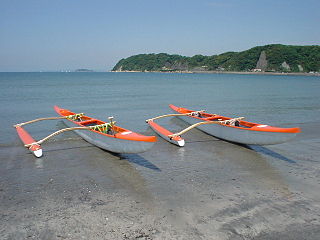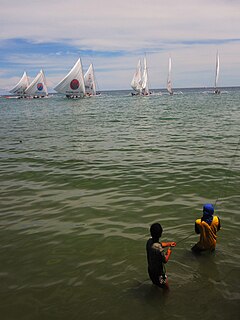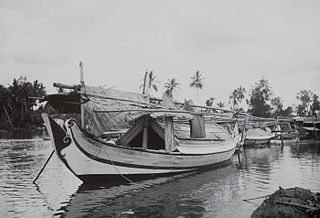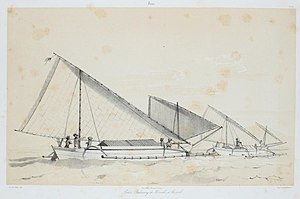
A sail plan is a description of the specific ways that a sailing craft is rigged. Also, the term "sail plan" is a graphic depiction of the arrangement of the sails for a given sailing craft.

Outrigger boats are various watercraft featuring one or more lateral support floats known as outriggers, which are fastened to one or both sides of the main hull. They can range from small dugout canoes to large plank-built vessels. Outrigger boats can also vary in their configuration, from the ancestral double-hull configuration (catamarans), to single-outrigger vessels prevalent in the Pacific Islands and Madagascar, to the double-outrigger vessels (trimarans) prevalent in Island Southeast Asia. They are traditionally fitted with Austronesian sails, like the crab claw sails and tanja sails, but in modern times are often fitted with petrol engines.

Proas are various types of multi-hull outrigger sailboats of the Austronesian peoples. The terms were used for native Austronesian ships in European records during the Colonial era indiscriminately, and thus can confusingly refer to the double-ended single-outrigger boats of Oceania, the double-outrigger boats of Island Southeast Asia, and sometimes ships with no outriggers or sails at all.

A jukung or kano, also known as cadik is a small wooden Indonesian outrigger canoe. It is a traditional fishing boat, but newer uses include "Jukung Dives", using the boat as a vehicle for small groups of SCUBA divers.

Literally, the word pinisi refers to a type of rigging of Indonesian sailing vessels. A pinisi carries seven to eight sails on two masts, arranged like a gaff-ketch with what is called 'standing gaffs' - i.e., unlike most Western ships using such a rig, the two main sails are not opened by raising the spars they are attached to, but the sails are 'pulled out' like curtains along the gaffs which are fixed at around the centre of the masts.

The term lambo or lamba refer to two types of traditional boats from Indonesia.

The term bedar,, is applied to a wide variety of boats of the east coast of Malaysia that carry one or two junk sails and lack the typical transom stern of the perahu pinas. These junk rigged boats are usually built in the Terengganu area. The stern of the bedar is a classical "canu" or "pinky stern," being a typical "double ender", a bit like a modern ship's lifeboat, with a very full turn of the bilge and with markedly raked stem and stern. They came in small versions as small one-masted fishing vessels - anak bedar and were built as big as 90 feet over deck (LOD). The majority of the bedars were usually 45 to 60 feet over deck. The bedar, like all Terengganu boats, was built of Chengal wood by the Malays since the 19th century and roamed the South China Sea and adjacent oceans as a highly seaworthy traditional sailing vessel.

A Sandeq is a type of outrigger sailboat or trimaran used by the Mandarese people for fishing and as a means of transportation between islands. The size of Sandeq varies, with hulls ranging from 5 to 15 metres long and 0.5 to 1.5 metres wide. Its carrying capacity ranges from a few hundred kilograms to over 2 tons. The sleek shape of the Sandeq makes it more agile and faster than other sailboats. The name of the vessel comes from a word in the Mandar language that means pointy, referring to the bow's shape.

Padewakang were traditional boats used by the Bugis, Mandar, and Makassar people of South Sulawesi. Padewakang were used for long distance voyages serving the south Sulawesi kingdoms.

Perahu Mayang or simply mayang is a type of fishing boat from Java, Indonesia. This type of boat is used mainly for fishing and trading. Historically, this indigenous vessel is also favored by European skippers and private merchants for trading in East Indies: 50% of them were using mayang and pencalang. It is mostly used in northern coast of Java. The major production site is in Rembang, Central Java.

Patorani is a traditional fishing boat from Makassar, Indonesia. It is used by Macassan people for fishing, transport, and trading since at least 17th century A.D. Historically this type of boat was used by Gowa Sultanate as war boat.

Golekan is a type of traditional boat from Madura, Indonesia. They once plied as far as Singapore, where they are referred to as Madurese traders. In the present this type of boat is only known locally, especially near Bangkalan in Western Madura and around the Kangean islands.

Leti leti is a type of traditional transport vessel from East Madura, Indonesia, especially from the administrative district of Sumenep. The leti leti is a recent development, the hull form and sail were developed in the 19th century. In 1979 sailing leti leti was numbered about 1000, but this was reduced in the next decades when more modern, motorized vessel appeared.

Lis-alis is a type of traditional boat of Madura, Indonesia. Lis-alis usually present in canals that provide salt evaporation service in southern part of Madura and around Surabaya. Until the present, lis-alis remained overwhelmingly popular as a fishing craft in Bangkalan and Sukolilo, while a larger version, the kroman, has been used in this area for at least a century for inshore transport work.

Janggolan refers to two different type of perahu from Indonesia. One is from Madura, and the other from Bali. The Madurese janggolan is a type of indigenously constructed boat, meanwhile Balinese janggolan is an indigenous boat with western-styled hull construction.

Palari is a type of Indonesian sailing vessel from South Sulawesi. It was mainly used by the people of Ara and Lemo Lemo, for transporting goods and people. This vessel is rigged with pinisi rig, which often makes it better known as "Pinisi" instead of its name. In Singapore, palari is known as "Makassartrader".

Pajala is a type of traditional perahu from western South Sulawesi, Indonesia. It is used mainly for fishing, but in the present it's a Bugis/Makassar name for small to medium-sized boat hull.

A bago is a traditional boat built by the Mandar people of Sulawesi, Indonesia. The hull is of the pajala-type, lightly built and allowing for shallow displacement. The boat is long, with the mast only making up a quarter of its length. A bago can be readily identified as Mandarese boat by its rudderpost style. Smaller-sized bagos are often used as fishing boats from which fishermen cast their nets. The Mandar people prefer using a bago over an outrigger canoe.

Bagan or bagang is a fishing instrument that uses nets and lights so that it can be used for light fishing, originating from Indonesia. Bagan is floated out to the sea to catch fishes, squids, and shrimps, and remain in the sea for several days or even months. The catch would be transported to land using other boats.

Bangkong is the war boat of dayak people, notably used by sea dayaks of Indonesia, Malaysia and Brunei. They are used for riverine warfare in Borneo, but they are also capable of sailing across the sea.


























